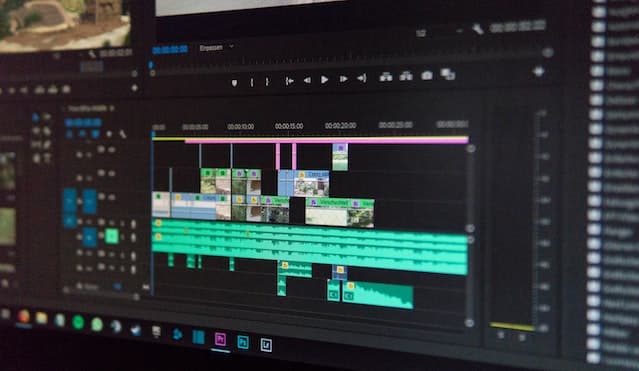Introduction: The Dawn of Video Editing
Once upon a time, video editing was limited to dedicated professionals wielding razor blades and splicing tape. With the advent of technology, the art of video editing and production has evolved significantly, democratizing its use to enthusiasts and professionals alike. In this journey through time, let’s explore the progressive developments in video editing software and their impact on the world of video production.
The Age of Analog: The 1960s-1980s
Before digital technology, video editing was a laborious process using analog tools like reel-to-reel videotape recorders and flatbed editing tables. Video editors would physically cut and splice tape together to create their final product. The 1980s saw the development of the first non-linear editing systems, such as the Sony Edit Station, which simplified sequencing by allowing for frame-by-frame editing on tape. Analog editing had several limitations, including loss of video quality and challenges in making precise edits due to physical constraints.
Digital Revolution: The 1990s
The 1990s witnessed the shift from analog to digital editing systems. Pioneers included Apple with its QuickTime software, Avid with the Media Composer, and Adobe with Premiere. Digital editing brought remarkable innovations such as direct access to frame-accurate editing and remarkable improvements in video quality. This era introduced the concept of non-linear editing, which allowed more flexibility and creativity in manipulating video footage than traditional linear methods.

Accessibility for All: Late 1990s to Early 2000s
As personal computers became more capable, the late 1990s and early 2000s saw a boom in consumer-level editing software. Apple introduced iMovie, and Windows bundled its Movie Maker software with new computers. This period marked the democratization of video editing, giving everyday users easy-to-use tools to create and share their own videos. This accessibility spurred the further growth of user-generated content.
As the demand for video editing continued to grow, it became crucial to ensure that digital infrastructure and hardware were capable of handling increasingly complex tasks. Nowadays professional IT support services can help maintain a smooth workflow by providing technical assistance, troubleshooting issues, and optimizing system performance for video editors. With expert support, video editors can focus on the creative process, while IT professionals handle the technology behind the scenes.
The Era of Special Effects: Mid-2000s
By the mid-2000s, software developers began to incorporate more advanced features into editing programs. Users could now add special effects, transitions, and titles, enabling more sophisticated storytelling. Examples included tools like Apple’s Final Cut Express and Sony’s Vegas, which introduced professional-level capabilities within reach of the average user, bridging the gap between consumer and professional editing solutions.
Collaboration and Cloud Computing: Late 2000s to Early 2010s
As the internet became ubiquitous, video editing software began to leverage the power of the cloud, facilitating real-time collaboration and centralized storage. Cloud-based editing allowed multiple users to work simultaneously on projects, streamlining workflows and making it easier to share files with clients or team members. Concurrently, video-sharing websites such as YouTube fueled the demand for software that simplified video editing for less tech-savvy users.
Mobile Editing and the Social Media Boom: Mid-2010s to Present
With the surge in smartphone usage and the proliferation of social media platforms, video editing has become an essential tool for content creators on the go. Today’s apps, such as Adobe Premiere Rush and LumaFusion, allow users to edit footage directly on their mobile devices. This technology has further democratized video production, enabling people to produce professional-looking content with just a few taps on their smartphones.
The Rise of AI-Powered Editing: Present and Beyond
As artificial intelligence advances, software to edit videos is starting to incorporate AI-driven features that can streamline and improve the editing process. AI technologies such as machine learning and computer vision enable the automation of certain tasks, including color grading, sound design, and even editing suggestions based on storytelling patterns. These AI-driven features can help creators save valuable time without sacrificing creative control and will continue to progress as AI becomes more prevalent in the industry.

Virtual Reality and Remote Editing
As virtual reality (VR) and 360-degree video gain popularity, new challenges arise for video editing software. Programs like Adobe Premiere Pro and CyberLink PowerDirector now offer built-in tools to edit and refine VR content, which allows users to immerse their audience in unique experiences. These innovative formats require new techniques and capabilities that will continue to push the boundaries of video production software.
Amidst a rapidly changing world due to the COVID-19 pandemic, remote work has become a necessity for many people, including video editors. To support this shift, video software companies are now focusing on collaboration and online workflow tools that allow teams to work together from anywhere in the world. As remote work becomes more ubiquitous, it’s likely that video editing software will continue to evolve to meet these newfound needs.
Conclusion: The Ever-changing Landscape of Video Editing
The evolution of video editing software has transformed the creative process, breaking down barriers, and empowering millions of people worldwide to express their ideas through the medium of video. With new developments and innovations unfolding rapidly, video editing will undoubtedly continue to push creative boundaries, disrupting and enriching the world of video production along the way.














Leave a Reply